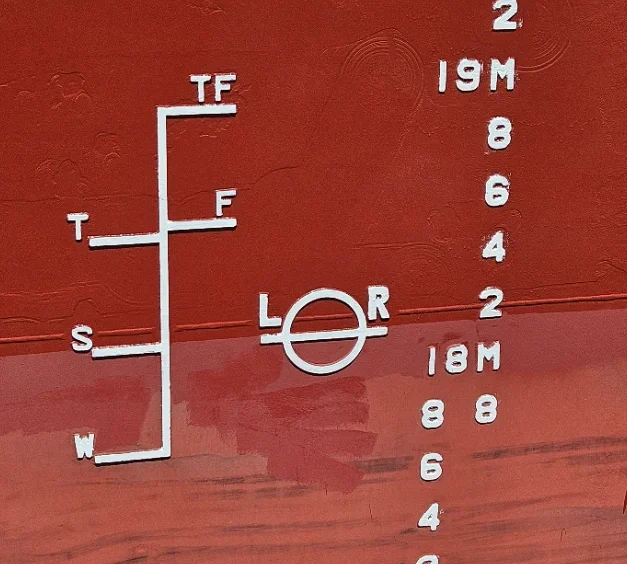Introduction
Every ship has a load it can safely bear. Beyond this threshold stability, buoyancy and free board are decreased with the vessel exposed to risk of flooding and capsizing.
The hull of the ship is marked by a Load Line or Plimsoll Line indicating the standard value for water density. It’s one of the most important safety rules in international maritime law.
To a deck cadet, it may appear to be just “a set of painted lines.” But to a Master, Chief Officer or Surveyor, the Load Line is a legal, technical and safety cornerstone that can never be compromised.
Historical Context – Why the Plimsoll Line Was Born
Shipowners in the 1800s frequently overloaded ships to squeeze out a few more dollars of profit. These ships, known as “coffin ships”, often went down with great loss of life.
You could have been drowned…popular British MP Samuel Plimsoll fought for legislation to stop this.
In 1876, the Load Line became compulsory in the UK under the Merchant Shipping Act.
This idea was later enshrined internationally in the International Load Line Convention (1930, as amended).
Nowadays, no commercial ship longer than 24 m can legally sail without an International Load Line Certificate.
Location & Appearance on the Ship
Painted amidships on both port and starboard sides.
Consists of:
- Plimsoll Disc → A 300 mm diameter circle with a 25 mm thick line through its center.
- Load Line marks → Horizontal lines extending forward of the disc, labeled with seasonal codes.
- Deck Line → A 300 mm × 25 mm line painted on the ship’s side at the level of the freeboard deck.
Detailed Components of the Load Line Mark
The Load Line system accounts for seasonal changes, water density, and geographical zones.
- TF – Tropical Fresh Water
- F – Fresh Water
- T – Tropical Seawater
- S – Summer Seawater (reference baseline)
- W – Winter Seawater
- WNA – Winter North Atlantic (most restrictive, severe weather area)
The Summer Load Line (S) is the reference from which others are calculated.
The difference between Fresh Water and Seawater marks represents the Fresh Water Allowance (FWA).
Why Ships Need a Load Line
- Stability → Prevents excessive loading that reduces GM (metacentric height).
- Reserve Buoyancy → Ensures enough freeboard to withstand waves and flooding.
- Structural Integrity → Avoids hull stresses from over-immersion.
- Legal Requirement → Sailing overloaded is a criminal offense under SOLAS & Load Line Convention.
- Insurance & Commercial Compliance → No insurance cover if found overloaded.
Technical Calculations – How Load Lines Are Determined
Load Line assignment is not random – it’s a result of freeboard calculations done by classification societies, based on the 1966 International Load Line Convention.
Key factors considered:
- Type of Ship → e.g., Tanker vs. Bulk Carrier.
- Length of Ship (Lpp).
- Block Coefficient (Cb).
- Sheer, Camber, and Superstructure.
- Watertight Integrity of hatch covers, doors, air pipes, ventilators.
- Minimum Bow Height & Reserve Buoyancy requirements.
Types of Freeboard Assignments:
- Type ‘A’ Freeboard Ships – e.g., tankers
High watertight integrity.
Assigned lower freeboard (can load deeper).
- Type ‘B’ Freeboard Ships – e.g., bulk carriers
Assigned higher freeboard (stricter).
Can apply for Reduced Freeboard if they meet additional watertight integrity requirements.
Seasonal Zones and Load Lines
The world’s oceans are divided into Load Line Zones, published in Chart NP 133C – Load Line Zones and Seasonal Areas.
Summer Zone → Default reference.
Tropical Zone → Allows deeper draft (more cargo).
Winter Zone → Requires lighter draft.
Winter North Atlantic (WNA) → Harshest, requires maximum freeboard.
Fresh Water Allowance (FWA) → Compensation for lower density of fresh water.
A Master must always check the Load Line Zone before loading and during passage planning.
Load Line Survey & Certification
Ships undergo inspection before being issued a certificate. Surveyors verify:
Hull strength & condition.
Closing appliances – hatch covers, doors, manholes
Ventilators, air pipes, freeing ports.
Guard rails, bulwarks, and closing arrangements.
Openings above freeboard deck are watertight.
International Load Line Certificate
- Valid for 5 years.
- Requires annual/intermediate surveys by Class or Flag.
- Endorsements are mandatory for continued validity.
Practical Notes for Officers & Cadets
Deck Line vs Load Line: The gap between them represents the assigned freeboard.
Check FWA: During loading in fresh water ports (e.g., river ports), calculate the draft allowance correctly.
Port State Control (PSC) → Inspectors frequently check if the ship is overloaded beyond the line.
RightShip / Vetting Inspections → Any overloading is a serious deficiency.
Always trim correctly → Overloaded at midships but not corrected for trim can still violate load line compliance.
Conclusion
The Plimsoll Line is not just a historical mark—it is a living international law ensuring ships sail safely in all conditions.
For cadets, it’s the first lesson in ship safety.
For officers, it’s a daily responsibility.
For surveyors and inspectors, it’s the final checkpoint before a voyage.
Knowing how to read, calculate, and comply with Load Line regulations is one of the core skills of a professional mariner.


